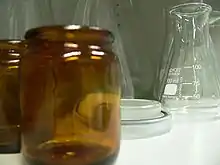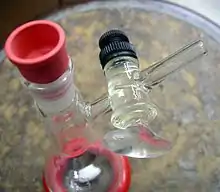Laboratory glassware
Laboratory glassware refers to a variety of equipment used in scientific work, and traditionally made of glass. Glass can be blown, bent, cut, molded, and formed into many sizes and shapes, and is therefore common in chemistry, biology, and analytical laboratories. Many laboratories have training programs to demonstrate how glassware is used and to alert first–time users to the safety hazards involved with using glassware.

History
.jpg.webp)
The history of glassware dates back to the Phoenicians who fused obsidian together in campfires making the first glassware. Glassware evolved as other ancient civilizations including the Syrians, Egyptians, and Romans refined the art of glassmaking. The art of glassmaking in 16th century Venice was refined to the point intricate shapes could be made. Some time before the turn of the 19th century laboratory glass manufacture from soda lime started in Germany. Most laboratory glassware was manufactured in Germany up until the start of World War I. Before World War I, glass producers in the United States had difficulty competing with German laboratory glassware manufacturers because laboratory glassware was classified as educational material and was not subject to an import tax. During World War I, the supply of laboratory glassware to the United States was cut off. [1]
In 1915 Corning Glassworks developed borosilicate glass, which was a boon to the war effort in the United States. Though after the war, many laboratories turned back to imports, research into better glassware flourished. Glassware became more immune to thermal shock while maintaining chemical inertness. Further important technologies impacting the development of laboratory glassware included the development of polytetrafluoroethylene, and a drop in price to the point laboratory glassware is, in some cases, more economical to throw away than to re-use.[2]
Laboratory glassware selection
Laboratory glassware is typically selected by a person in charge of a particular laboratory analysis to match the needs of a given task. The task may require a piece of glassware made with a specific type of glass. The task may be readily performed using low cost, mass-produced glassware, or it may require a specialized piece created by a glass blower. The task may require controlling the flow of fluid. The task may have distinctive quality assurance requirements.
Type of glass

Laboratory glassware may be made from several types of glass, each with different capabilities and used for different purposes. Borosilicate glass is transparent and can withstand thermal stress. Quartz glass can withstand very high temperatures and is transparent in certain parts of the electromagnetic spectrum. Darkened brown or amber (actinic) glass can block ultraviolet and infrared radiation. Heavy-wall glass can withstand pressurized applications. Fritted glass is finely porous glass through which gas or liquid may pass. Coated glassware is specially treated to reduce the occurrence of breakage or failure. Silanized (siliconized) glassware is specially treated to prevent organic samples from sticking to the glass.[3]
Scientific glass blowing
Scientific glass blowing, which is practiced in some larger laboratories, is a specialized field of glassblowing. Scientific glassblowing involves precisely controlling the shape and dimension of glass, repairing expensive or difficult-to-replace glassware, and fusing together various glass parts. Many parts are available fused to a length of glass tubing to create highly specialized piece of laboratory glassware.
Controlling fluid flow






When using glassware it is often necessary to control the flow of fluid. It is commonly stopped with a stopper. Fluid may be transported between connected pieces of glassware. Types of interconnecting components include glass tubing, T-connectors, Y-connectors, and glass adapters. For a leak-tight connection a ground glass joint is used (possibly reinforced using a clamping method such as a Keck clips). Another way to connect glassware is with a hose barb and flexible tubing. Fluid flow can be switched selectively using a valve, of which a stopcock is a common type fused to the glassware. Valves made entirely of glass may be used to restrict fluid flows. Fluid, or any material which flows, can be directed into a narrow opening using a funnel.
Metrology
Laboratory glassware can be used for high precision volumetric measurements. With high precision measurements, such as those made in a testing laboratory, the metrological grade of the glassware becomes important. The metrological grade then can be determined by both the confidence interval around the nominal value of measurement marks and the traceability of the calibration to an NIST standard. Periodically it may be necessary to check the calibration of the laboratory glassware.[4]
Dissolved silica
Laboratory glassware is composed of silica. Silica is considered insoluble in most substances with a few exceptions such as hydrofluoric acid. Though insoluble a minute quantity of silica will dissolve which may affect high precision, low threshold measurements of silica in water.[5]
Cleaning
Cleaning laboratory glassware is sometimes necessary and may be done using multiple methods. Glassware can be soaked in a detergent solution to remove grease and loosen most contaminations. These contaminations are then scrubbed with a brush or scouring pad to remove particles which cannot be rinsed. Sturdy glassware may be able to withstand sonication as an alternative to scrubbing. For certain sensitive experiments glassware may be soaked in solvents, such as aqua regia or mild acids, to dissolve a trace quantities of specific contaminations known to interfere with an experiment. When cleaning is finished it is common practice to triple rinse glassware before suspending it upside down on drying racks.[6]
Examples
There are many different kinds of laboratory glassware items:
Examples of glassware containers include:
- Beakers are simple cylindrical shaped containers used to hold reagents or samples.
- Flasks are narrow-necked glass containers, typically conical or spherical, used in a laboratory to hold reagents or samples. Examples flasks include the Erlenmeyer flask, Florence flask, and Schlenk flask.
- Bottles are containers with narrow openings generally used to store reagents or samples. Small bottles are called vials.
- Jars are cylindrical containers with wide openings that may be sealed. Bell jars are used to contain vacuums.
- Test tubes are used by chemists to hold, mix, or heat small quantities of solid or liquid chemicals, especially for qualitative experiments and assays
- Desiccators of glass construction are used to dry materials or keep material dry.
- Glass evaporating dishes, such as watch glasses, are primarily used as an evaporating surface (though they may be used to cover a beaker.)
- Glass Petri dishes are used to culture living cells.
- Microscope slides are thin strips used to hold items under a microscope.
Examples of glassware used for measurements include:
- Graduated cylinders are cylindrical containers used for volumetric measurements.
- Volumetric flasks are for measuring a specific volume of fluid.
- Burettes are used to disperse precise amounts of liquid reagents.
- Glass pipettes are used to transfer precise quantities of fluids.
- Glass Ebulliometers are used to accurately measure the boiling point of liquids.
Other examples of glassware includes:
- Stirring rods are used to mix chemicals.
- Condensers are used to cool hot liquids or vapors.
- Glass retorts are used for distillation.
- Drying pistols are used to free samples from traces of water, or other impurities.
References
- Jensen, William (2006). "The origin of pyrex". Journal of Chemical Education. 83 (5): 692. Bibcode:2006JChEd..83..692J. doi:10.1021/ed083p692.
- Donnelly, Alan (March 1970). "History of Laboratory Glassware". Laboratory Medicine.
- Bhargava, Hemendra (1977). "Improved Recovery of Morphine from Biological Tissues Using Siliconized Glassware". Journal of Pharmaceutical Sciences. 66 (7): 1044–1045. doi:10.1002/jps.2600660738. PMID 886442.
- Castanheira, I. (2006). "Quality assurance of volumetric glassware for the determination of vitamins in food". Food Control. 17 (9): 719–726. doi:10.1016/j.foodcont.2005.04.010.
- Zhang, Jia-Zhong (1999). "Laboratory glassware as a contaminant in silicate analysis of natural water samples". Water Research. 33 (12): 2879–2883. doi:10.1016/s0043-1354(98)00508-9.
- Campos, M.L.A.M. (2007). "Dissolved organic carbon in rainwater: Glassware decontamination and sample preservation and volatile organic carbon". Atmospheric Environment. 41 (39): 8924–8931. Bibcode:2007AtmEn..41.8924C. doi:10.1016/j.atmosenv.2007.08.017.
External links
| Wikimedia Commons has media related to Laboratory glassware. |
- Smithsonian Science Under Glass
- Chemistry Laboratory Glassware at About.com
- Project Gutenberg - On Laboratory Arts by Richard Threlfall (1898)
- Project Gutenberg - Laboratory Manual of Glass-Blowing by Francis C. Frary (1914)
- Project Gutenberg - A Handbook of Laboratory Glass-Blowing by Bernard D. Bolas (1921)